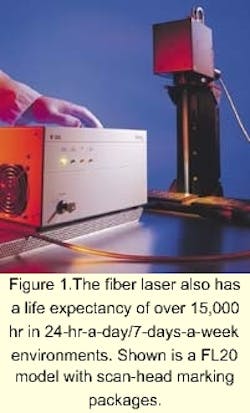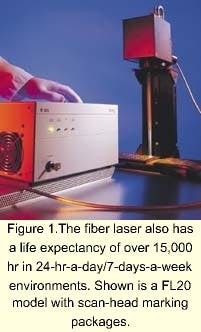Fiber lasers target manufacturing
Brian Rossi
Unlike conventional solid-state lasers that use a crystal rod for the lasing medium, a fiber laser uses a long double-clad optical fiber that has been doped with a rare-earth lasing material and pumped with a single high-power laser diode. This configuration makes a fiber laser immune to misalignment and contamination. High conversion efficiency and minimal losses result in a very compact, air-cooled and highly reliable laser (see figure).
Manufacturing engineers at companies that produce miniature parts in high volume have found the fiber laser a unique tool in performing specific processing tasks. These tasks include small-scale bending, soldering, welding, and marking of thin metals and plastics. Engineers have replaced both laser and nonlaser-based processes. The decision to adopt fiber laser technology in these material-processing applications is supported by its history of high performance and reliability in the graphic arts market.
A major manufacturer of hard-disk drives and their components uses a fiber laser to precisely bend the small magnetic recording head located on an armature to achieve the fly characteristics necessary for close-proximity hard-disk reading and writing. The previously used lapping process that worked with larger recording heads proved to be increasingly difficult with the newer miniature read-write head formats. The manufacturer looked for ways to create a more accurate and repeatable bend in the new smaller recording head. A highly focused beam of laser light not only delivered precisely the amount of heat required for the delicate bend, but also minimized undesirable distortions by not physically contacting the part.
Supplemental benefits include the fact that there are no wearing parts or consumables present in the manufacturing process, as well as minimal operator involvement. The company thus saved on material and labor costs. In this application alone there are numerous systems installed working 24 hr a day, 7 days a week. It is also worth noting that the company initially used a diode-pumped solid-state laser to prove the process. A migration to the fiber laser was made due to its higher beam quality and increased power stability. This resulted in a higher degree of control and repeatability in the bending process. In addition, the company realized the benefits associated with more efficient and robust technology.
A producer of miniature optical components uses a fiber laser to selectively re-solder individual components onto 300-µm-wide solder pads. As these components on the pads have become smaller, the relatively large size of the soldering irons became an issue. This prevented the user from precisely delivering the required amount of heat without affecting adjacent solder joints and other heat-sensitive components. The fiber laser easily delivered a 300-µm spot at a distance greater than 5 cm from the output lens of the laser system. To perfect the soldering process, variations in pulse shaping were performed, a feature not possible with soldering iron technology.
Fiber lasers also show considerable promise in micro welding of small-scale components. The Fraunhofer Institut Lasertechnik (ILT; Aachen, Germany) is involved in a program called Clean and Low-Distortion Accurate Welding for Micro-assemblies (CLAW). Project tasks are accomplished through joint efforts by an interdisciplinary team of 12 project partners from five European countries. Present welding techniques leave undesirable debris and distortion in miniature parts like crowns, gears, and armatures used in watches. The fiber laser's high-quality finely focused continuous-wave beam results in minimal undesirable debris generation and thermo-mechanical distortion. The goal is a novel, industrial-scale micro-welding process with low distortions in the range of 0.5 µm in position and 1 mrad in angle, as well as a total assembly time of 2 sec (including handling and manipulation).
Integrated circuit manufacturers have replaced inefficient CO2 and flashlamp-pumped Nd:YAG pulsed laser marking systems with fiber-laser-based marking systems. The fiber laser makes legible permanent marks on a wide variety of semiconductor molding compounds, lead frames, and wafers, as well as ceramic substrates and packages. A significant advantage of a fiber-laser-based marking systems is its ability to make unintrusive marks using the continuous-wave operating mode as opposed to the nonuniform marks of typical pulsed (Q-Switched) flash-lamp-pumped or diode-pumped solid-state laser systems. This becomes important when dealing with packages that have only a thin layer of molding compound over the die and wire bonds.
Fiber lasers have been particularly successfully as imaging tools in the graphics arts industry where they have been operating for several years and have tallied an outstanding reliability record. Polaroid Graphics Imaging, LLC uses a fiber laser as the print engine in its four-color prepress proofing system. Another major graphic arts equipment supplier markets a thermal computer-to-plate imaging system where the fiber laser exposes thermal plates that are used in high-resolution printing.
Results from the field indicate that the fiber laser is a very high reliability "engine" based on an installed base of over 1000 systems over the last four years. In addition, artifact-free superior image quality is obtained in progressing from the previously used flashlamp-pumped and diode-pumped solid-state lasers exhibiting the inherently less stable and inferior beam quality output. The fiber laser also has a life expectancy of over 15,000 hr in 24 hr-a-day/7 days-a-week environments.
In most laser systems, routine maintenance is a constant activity. In flash-lamp-pumped systems, flash lamps must be replaced every 500 - 1000 hr. In diode-pumped solid-state lasers, the expensive diode bars must be replaced every year or so. In both cases, there are alignment and contamination issues due to the open resonator structures, which require intervention to maintain peak performance.
The fact that the fiber laser is a compact, air-cooled, "plug and play" component fitting into any manufacturing line and lasting many years without replacement further justifies its attractiveness from a financial standpoint. In conclusion, the fiber laser can become the tool of choice for many micromaterials processing applications because of its combination of efficiency, reliability, and performance make it an efficent option for those involved in the ever-increasingly difficult processing steps required to effectively manufacture miniature assemblies.
Brian Rossi is a product marketing manager for the Industrial Laser Group at SDL Inc., San Jose, CA. Contact him at (P) 408-943-9411 or e-mail [email protected].

